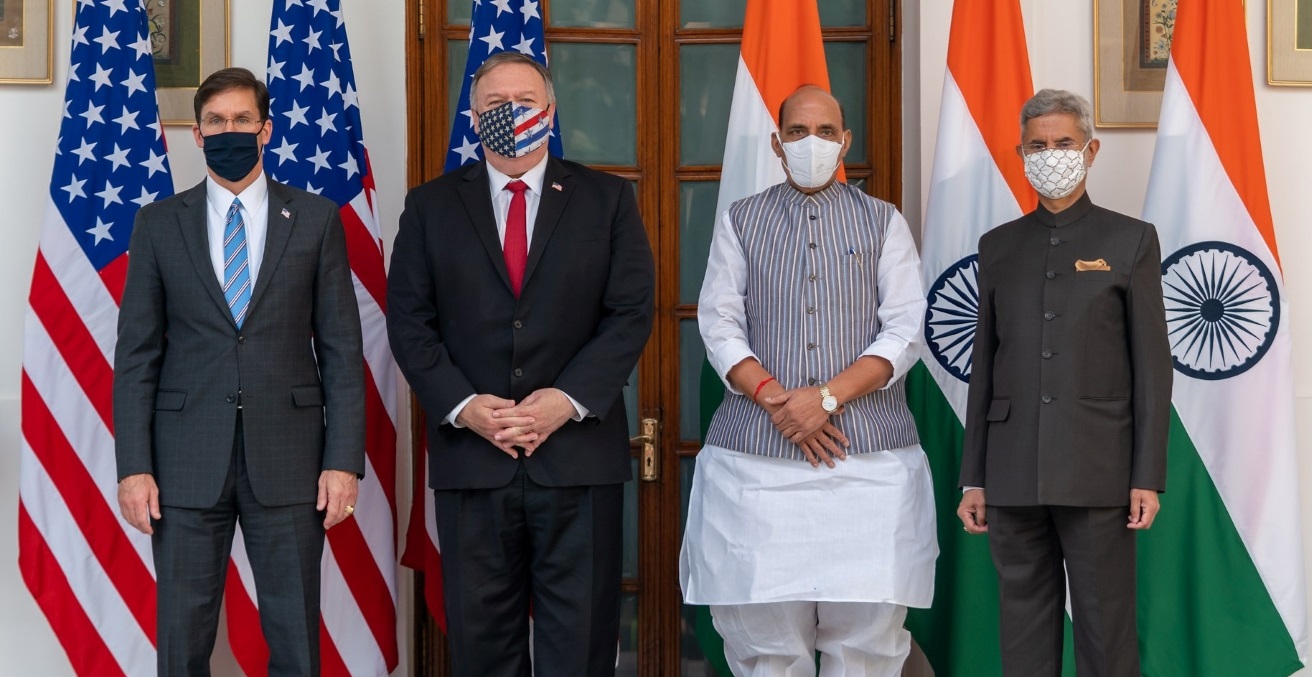The Third India-US 2+2 Dialogue: Defence, China, and Indo-Pacific Security

India and the United States have forged a defining partnership of the 21st century grounded in their shared democratic values, common public good, and converging security interests. The 2+2 Dialogue further strengthens the US-India Comprehensive Global Partnership.
The US-India strategic partnership achieved another milestone on October 27. Indian Minister of Defence Rajnath Singh and Minister of External Affairs S. Jaishankar hosted US Secretary of State Michael R. Pompeo and Secretary of Defense Mark T. Esper for the third annual U.S.-India 2+2 Ministerial Dialogue in New Delhi.
What has been concluded?
The US-India relationship is comprehensive, and the 2+2 US-India Ministerial Dialogue deliberated on a range of issues. Both sides took much-needed steps to enhance cooperation in the healthcare field by reaffirming their collaboration to develop vaccines, therapeutics, and essential medical equipment, and taking initiatives to set up an International Center of Excellence in Research to deal with infectious diseases, including COVID-19. Both sides also assessed the progress and prospects of energy security, sustainable financing for infrastructure development, cyber security, and counter-terrorism. The duration of the MoU on Global Center for Nuclear Energy Partnership was extended, and a letter of intent for collaboration in traditional Indian medicines was signed.
But the highlight of the meeting was the conclusion of the Basic Exchange and Cooperation Agreement (BECA) , which puts a final stamp on the India-US military and logistic partnership. The agreement enhances defence ties, addresses concerns around China’s authoritativeness and geopolitical ambition, and strengthens the Indo-Pacific strategy and security.
BECA is a landmark defence agreement that paves the way for geospatial information sharing cooperation between their armed forces. BECA is the final element of the four major agreements between the US and India. The General Security of Military Information Agreement (2002), the Logistics Exchange Memorandum of Agreement (2016), and the Communications Compatibility and Security Agreement (2018) for the exchange of military logistics, intelligence sharing, and safe communications were signed by the US and India before BECA. These agreements have been crucial for institutionalising, strengthening, and expanding the India-US strategic partnership.
BECA will allow India to access US military satellites, confidential geospatial information, sensitive satellite and sensor data, and topographical images. It will help India carry out more accurate airstrikes and missile attacks on its enemies and track Chinese warship movements in the Indian Ocean.
BECA took some time to be concluded as concerns were raised regarding the accessibility of secret and militarily sensitive information to foreign countries in India. However, a series of bilateral talks resolved these concerns. The bonhomie, mutual trust, confidence, and interoperability between the two forces that have been built over the last two decades have been significant in the culmination of BECA.
Geopolitics Significance: Indo-Pacific and the World
Over the past decade, the Chinese Communist Party (CCP) has been seeking to assert and advance its model of authoritarianism. The US considers this a serious threat to its values for a free and democratic world. The US ramped up its assault on CCP tyranny during the COVID-19 period, as evidenced in the slamming of China’s authoritarianism by Pompeo and US President Donald Trump. They have stressed that the fight in the world is between democracy and authoritarianism. To this end, both countries continue to deepen their strategic partnership, which is grounded in the shared democratic values and principles.
The 2+2 meeting left no stone unturned in taking swipe at China’s aggressive military posture to advance its geopolitical intent amidst the world’s biggest humanitarian crisis. China has not been only confined to the Indo-Pacific region. It has its sights set on the entire world, as evident in the Belt and Road Initiative throughout Africa, the Middle East, and the Indo-Pacific. The meeting was unambiguous in exposing the Chinese ambition of global dominance.
This was clearly emphasised in the discussion that the strategic partnership not be confined to the regional level but elevated to the global level. “We can be force multipliers and deliver really good outcomes not only for the people of India or the Indo-Pacific but for the entire world,” Pompeo emphasised during the meeting.
The security issues created byunilateral Chinese territorial claims and aggressive geopolitical moves in the Indo-Pacific dominated the 2+2 meeting. Incidents of the Chinese military challenging the US primacy and threatening allies and partners in the Indo-Pacific region have been increasing. The US moving a significant number of troops from the European theatre to the Indo-Pacific is an important development in the US Indo-Pacific strategy, which has been evolving since the beginning of the 21st century. Under the past three US presidents, the strategic partnership with India has been given top foreign policy priority to balance the rise of an aggressive China.
COVID-19 has exposed the over-reliance of the global supply chains on China, and China’s geopolitical intent in the Indo-Pacific. India has emerged as a significant player both from the strategic point of view and as potentially the only country to match China’s manufacturing scale. China’s belligerent approach, the China-Pakistan nuclear and defence nexus, China’s support for Pakistan’s terrorist harbouring policy at the United Nations, China’s India-encircling “String of Pearls” strategy, and the recent deadly Galwan Valley clash have aggravated India’s security concerns.
At a time when India faces a major security threat through Chinese aggression along the Line of Actual Control in eastern Ladakh, the US support for India has further deepened mutual trust and confidence. As the rules-based order and peace of the Indo-Pacific are seriously challenged, the 2+2 dialogue is timely. The US-India partnership is comprehensive and its economic, political, and strategic significance has acquired further prominence, mainly because of China’s flaunting of economic and military power in recent months.
The Comprehensive Global Partnership between the world’s oldest and largest democracies is going to be strengthened further as the strategic convergence has no limit amidst Chinese authoritarianism and ambition for global dominance. The combined influence and capability of the US and India are not only a force-multiplier for Indo-Pacific strategy, the ongoing relationship also has greater ramifications for global prosperity, governance, and security.
Dr Ashok Sharma is a Visiting Fellow at the University of New South Wales Canberra at the Australian Defence Force Academy and an Adjunct Associate Professor at the University of Canberra. He is also the Deputy Chair of the New Zealand Institute of International Affairs, Auckland Branch. His latest book is India’s Pursuit of Energy Security: Domestic Measures, Foreign Policy and Geopolitics.
This article is published under a Creative Commons Licence and may be republished with attribution.





